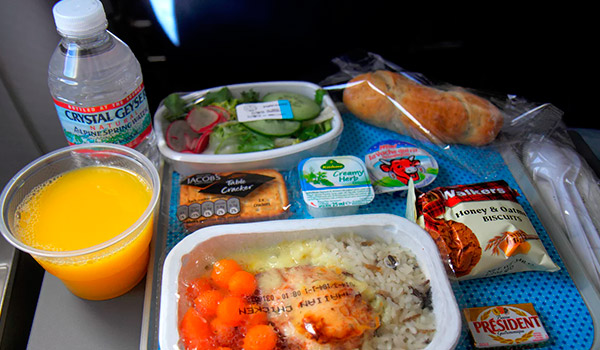Airlines generated 5.2m tonnes of waste in 2016, most of which went to landfill or incineration – and it cost them £400m
You probably know about the waste problem in our oceans. But how about the one in our skies?
Airline passengers generated 5.2m tonnes of waste in 2016, most of which went to landfill or incineration, the International Air Transport Association (IATA) estimates. That’s the weight of about 2.6m cars. And it’s a figure set to double over the next 15 years.

Toilet waste is included in that statistic. But so are miniature wine bottles, half-eaten lunch trays, unused toothbrushes and other hallmarks of air travel.
Once a plane has landed, huge volumes of disposable items are thrown away, says Matt Rance, chief executive of MNH Sustainable Cabin Services, a company that advises airlines on waste reduction. “It’s almost like taking a tube, tipping it upside down, emptying it out and then saying ‘right, fill it up with new stuff again’.”
The airline industry has taken flak for its growing greenhouse gas emissions as passenger numbers rise. But could its massive waste footprint be solved without affecting the sector’s growth?
Stemming the tide
A Spanish project launched last autumn by a group of companies including Iberia Airlines and Ferrovial Services is taking up this challenge.
The scheme aims to recover 80% of cabin waste coming into Madrid’s Barajas airport by mid-2020 through simple measures such as using trolleys designed for waste separation, says Juan Hermira, Iberia’s lead for the project. About 2,500 cabin crew members will be trained in the basics of waste separation as part of the push, he says.
The programme, which aims to produce guidelines for use in other airports, is also exploring low-packaging meals and reusable cutlery, as well as data-led solutions: frequent flyer information, for example, could be used to anticipate business class passengers’ meal preferences, meaning fewer meals would need to be prepared to satisfy demand, says Hermira.
It’s one of a handful of initiatives that suggest parts of the industry are waking up to waste. Last year, Gatwick opened an on-site waste-to-energy plant, reducing the need for lorries to transport waste elsewhere. The power produced currently goes back into the plant, but Gatwick hopes the facility will eventually help to heat the north terminal. Like Heathrow, it is also targeting a 70% recycling rate by 2020.
America’s United Airlines has switched to compostable paper cups and last year began donating unused amenity kits to homeless and women’s shelters – it expects to divert more than 27 tonnes-worth by the end of the first year. Virgin, meanwhile, has set up a system for recycling all parts of its headsets, including ear sponges, which are used as flooring for equestrian centres.
Despite actions like these, the mountains of airline waste continue to grow. So what more can be done?
For Michael Gill, IATA’s head of environment, regulation is key. At the moment EU animal health legislation, drawn up as a reaction to diseases like foot and mouth, dictates that all catering waste arriving from outside EU borders be treated as high-risk and incinerated or buried in deep landfill. A coffee cup from the US, for example, will be treated as hazardous waste because it might have had milk in it. Donating uneaten food to charity is impossible.
A more rational approach is needed, Gill says, one which identifies elements of cabin waste that actually pose a risk to health and takes into account the stringent hygiene standards airlines are already subject to. He points to a forthcoming IATA-commissioned report which concludes that dairy and honey in airline waste pose a negligible threat to animals.
Better procedures on the ground would also help ease the classification problem, says Magda Golebiewska, group environment manager at TUI Airlines. East Midlands and Gatwick airports have started tagging rubbish bags with their origin but elsewhere it’s common practice for waste from inside and outside the EU to get thrown together and processed collectively as international catering waste, she says.
Most important, however, is getting the cabin crew’s buy-in, says Golebiewska. This can be a challenge since the crew is already busy meeting on-board sales targets and looking after passengers, she says, but it is crucial: “How well the [waste] segregation is done really depends on how much effort they put into it.”
Cutting costs
The environment is not the only concern on the minds of Golebiewska and others. Cabin waste costs the industry $500m (£400m) per year, according to IATA, a figure that it says is rising faster than waste volumes thanks to growing disposal costs.
Bringing this down will require airlines to take a different approach to procurement, says Rance. If they can be persuaded to focus on a product’s full life cost, rather than unit price, then investing in more durable headsets or blankets and ditching disposables starts to make sense, he says.
Designing cabin products with waste minimisation in mind can also help, he says. Qantas, for example, is combining its charity donation envelope with its headset package, cutting one polythene bag per passenger per flight.
In Gill’s mind there is another, less tangible, gain to be made by airlines that can show they are tackling waste: a better reputation. The sight of unopened bottles of water or meal trays being thrown away as passengers exit the aircraft is, he says, a highly visible illustration of the industry’s environmental impact.
